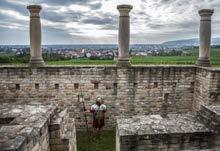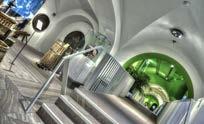
10 minute read
Pfalz
ON THE ROAD TO WINE PLEASURE
The Pfalz is a region of many superlatives: the world’s largest wine barrel and wine festival in Bad Dürkheim, the world’s oldest wine is the Palatinate Historical Museum in Speyer, as well as the first and best-known wine route, the German Wine Road. For 85 km (ca. 50 miles) it runs parallel to the foothills of the protective Haardt Mountains as it winds its way through the region’s 130 wine villages between Bockenheim and Schweigen on the border with Alsace. With more than 23,600 ha (58,300 acres) of vines, it is Germany’s second largest wine-growing region and comprises two districts, Bereich Mittelhaardt-Deutsche Weinstrasse and Bereich Südliche Weinstrasse.
Advertisement
Vintners in the Pfalz focus on traditional grape varieties, above all, riesling. The “king of white wine grapes” reigns supreme here, with a surface area of more than 5,800 ha (14,300 acres). Yet plantings of weiss- and Grauburgunder (Pinot Blanc and Pinot Gris) are also on the rise. other white varieties include Silvaner, Müller-Thurgau, Scheurebe, Gewürztraminer, Kerner and Morio-Muskat – in all, there’s quite a diversity of white wines produced in the Pfalz. red varietals are increasingly important. There’s lively, refreshing weissherbst (rosé) from Portugieser grapes and fruity Spätburgunder (Pinot Noir). dornfelder has been a remarkable success in the Pfalz and has been all the rage for the past few years. Usually vinified in a dry style, the deep-colored wines have an appealing Mediterranean charm. Another red varietal, regent, has been a similar story. Some 37 percent of the vines now cultivated between the rhine and Haardt Mountains are red, and thus, the Pfalz is the largest red wine region in Germany.
It’s a well-known fact that the people of the Pfalz love to celebrate as often as possible. The wine festival sea-

son begins in Neustadt-Gimmeldingen with the blossoming of the almond trees in March and continues through 11 November, St. Martin’s day, in the wine village named in his honor. Given the large number of festivals, it’s easy for visitors to lose track of things. Hence, a suggestion: attend the “erlebnistag,” an action-packed wine and folk festival the last Sunday in August, when the German wine road is closed to auto traffic and tasting stands line the entire route.
Like their neighbors in France, the people of the Pfalz are very fond of good food. over the years, quite a number of top chefs have opened restaurants here. They are well worth a visit, not least to sample creative interpretations of traditional regional specialties.
In addition, there are many tourist attractions in the Pfalz. Visits to the towns of Bad dürkheim, Neustadt and Landau are a must. No less inviting are the picturesque villages, such as St. Martin, rhodt, Gleiszellen or Annweiler am Trifels in the southern portion of the

PFALZ – AT A GLANCE
Geographical location: From south of worms down to the border with France, and from the slopes of the Pfalz Forest well into the rhine plain · Climate: High number of sunny days; average temperature of 11°C (51.8°F) · Soils: red sandstone, chalky loam and clay soils, marl and keuper soils, sprinklings of shell-limestone; isolated patches of granite, porphyry and clayish slate · Size: ca. 23,600 ha (58,300 acres) · Grape varieties: riesling, dornfelder, Müller-Thurgau, Spätburgunder (Pinot Noir), Portugieser, Grauburgunder (Pinot Gris), weissburgunder (Pinot Blanc)
region, and north of Bad dürkheim, Freinsheim and deidesheim. A bit further north is the charming Zellertal area. detours to castles or castle ruins can be made throughout the region. Those who make the ascent from eschbach to the Madenburg ruins, for example, will be rewarded with a sweeping view of the verdant rhine plain, and vines as far as the eye can see.
Information: Pfalzwein e. V. Martin-Luther-Straße 69 67433 Neustadt/weinstraße Tel. +49 (0)6321 912328 Fax +49 (0)6321 12881 www.pfalz.de info@pfalz.de
Pfalz: Landmarks of German Wine Culture
WEINGUT KREUTZENBERGER IN KINDENHEIM, PFALZ
Jochen Kreutzenberger is a man unafraid of the future. Particularly when it comes to innovative technologies in viticulture. Yet even Kreutzenberger first completes a painstaking early harvest in his vineyards before deploying his automated berry harvester. Any moldy, unripe and otherwise imperfect berries are removed from the vineyard by hand, thus ensuring that only healthy, ripe fruit is harvested by the machine.
Innovative and Modern weingut Kreutzenberger in the Pfalz town of Kindenheim sets the bar high when it comes to quality. Great wine, they believe, can only come from great fruit. As such, it all begins with rigorous early selection in the vineyard. The grapes then undergo a gentle pressing including cold fermentation in stainless steel tanks and cutting edge filtration techniques. A tour of the “transparent winery” allows visitors to follow the entire vinification process, from berry to bottle.
“The courage to follow new paths has always been a defining factor in our family,” says Jochen Kreutzenberger. His great-grand-

father emil was personally responsible for bringing the controversial Neue Sachlichkeit (New objectivity) style to the old wine village in 1929 when he built the winery in Bauhaus style, at the time considered avant-garde. Yet embracing the new doesn't mean forgetting what came before. with roots stretching back to 1438, the small family estate takes seriously its responsibility for some of the best sites in Kindenheim, Bockenheim and wachenheim.
Weingut Kreutzenberger Kindenheim, Hauptstraße 5 Tel. +49 (0)6359 4266 www.kreutzenberger.com
THE ROMAN ESTATE IN UNGSTEIN, PFALZ
2000 years ago the Romans determined that the sunny slopes of the Pfalz (Palatinate) highlands were the perfect place to cultivate grapevines. A villa rustica built in 20 – 30 AD stood in what is now the modern winegrowing village of Ungstein near Bad Dürkheim. By the 4th century it had developed into a distinguished country estate. Beyond the multistory manor, the grounds also contained a stall, a bathhouse with steambath and a press house.
Roman Varieties For 400 years, the harvest from the surrounding vineyards was delivered here, poured into two large vats and stamped underfoot. The must flowed into a third, deeper-set catch basin, to then be ladled into barrels. Based on seeds found near the Ungstein pressing

basins, we can today confirm that the varieties included early riesling, Traminer and Pinot grapes. estimates suggest that the press house handled the harvest from 30 to 40 hectares (75 – 100 acres). Based on historical yields at the time, that would have resulted in between 15,000 and 25,000 liters of wine per year. The villa rustica on the weilberg near Ungstein persisted until the 5th century before lapsing into disrepair and disappearing under the ground. rediscovered only in 1981, the villa rustica's existence was nevertheless preserved in the intervening centuries in the name of the fields: in 1309 the area was known as “zu wile” – derived from villa – as does the site's current name, “weilberg.”
Tourist-Information Bad dürkheim, Kurbrunnenstraße 14 Tel. +49 (0)6322 935140 www.bad-duerkheim.com

RHODT UNTER RIETBURG, PFALZ
There is a noticeable gnarled patch – primarily red-hued Traminer berries dotted with a few green Silvaner – in the Rhodter Rosengarten (rose garden) on the eastern edge of the town of Rhodt unter Rietburg. These vines are low-slung and twisted, unlike others that grow in the Pfalz. There's a reason: this is after all one of – if not THE – oldest active fruit-bearing vineyards in the world.
Rhodter Rosengarten The vines in the rhodter rosengarten were planted over 400 years ago and continue today to yield between 50 and 300 liters from just under a hectare (2.5 acres) of land. In good years over 400 liters of must are produced; in poor years little more than a few buckets. This can be attributed not least to the fact that Traminer vines are extremely challenging. Curiously, the roots of the vintner family that has been cultivating the rosengarten since 1970 are actually in the South Tyrolean town of Tramin. In 1754 the ancestors of the current owner left their homeland and emigrated to Germany. Stefan oberhofer assumed the helm of weingut oberhofer in edesheim in 2005. Since then he has aged the prized most in his cellar into spicy, mouth-puckering Traminer, with aromatic notes of roses that beautifully honor the moniker “rhodter rosengarten.”
Weingut Stefan Oberhofer edesheim, Am Linsenberg 1 Tel. +49 (0)6323 944911 www.weingutoberhofer.de
DEIDESHEIM – A WINE VILLAGE WITH TRADITION, PFALZ
There's a custom here of placing bundled vines within the old vaulted cellars. The reason: to remind all involved that the vineyard is where everything truly begins. More precisely, in the world-class vineyards around Deidesheim. There since 1849 the vines of Weingut Reichsrat von Buhl have been producing timeless, terroir-drenched wines unmarred by transient fashion or trend. Reichsrat Franz Eberhard Buhl was elected in 1913 as the first president of the German Winegrowers’ Association.
Honoring Tradition through a Pioneering Spirit Tradition is also writ large at weingut von winning in deidesheim. The vines are planted, as they have have been for over 100 years, at twice the “normal” density (9500 vines per hectare [2.5 acres]). while this cuts the expected yield to less than half, each individual vine is subjected to less stress and can better absorb the substances that promote quality.
For deidesheim winemakers, staying true to traditions also means not shying away from treading new paths. In 1802 the pretty little town on the east edge of the Haardt region was the site of the first Qualitätswein production in the Pfalz, when winery owner Andreas Jordan named his wines based on variety and site. In the mid-19th century deidesheim vintners pioneered the process of harvest selection, sorting grapes into separate carriers directly in the vineyard. This extra effort resulted in international acclaim for deidesheimer rieslings, perhaps most notably when they were poured at the celebration to consecrate the Suez Canal in 1869.
Weingut Reichsrat von Buhl deidesheim, weinstraße 18–24 Tel. +49 (0)6326 965019 www.von-buhl.de
Weingut von Winning deidesheim, weinstraße 10 Tel. +49 (0)6326 966870 www.von-winning.de
Weingut Geheimer Rat Dr. von Bassermann-Jordan deidesheim, Kirchgasse 10 Tel. +49 (0)6326 6006 www.bassermann-jordan.de
Museum für Weinkultur deidesheim, Historisches rathaus, Marktplatz 9 Tel. +49 (0)6326 981561 www.weinkultur-deidesheim.de

WINE MUSEUM OF SPEYER, PFALZ
The vaulted ceilings of the Historical Museum of the Pfalz are home to treasures such as the oldest extant (still fluid) grape wine in the world. Filled around 300 A.D., the wine was intended to accompany the dearly departed into the afterlife. The sensational find was discovered in a sarcophagus in a vineyard near Speyer. Although the grave goods also included other wine bottles, only one actually still contained Roman wine.
2000 Years of Wine in the Pfalz At the time of its opening in 1910, the Speyerer weinmuseum (Speyer wine Museum) was the world's first collection of this type open to the public. Today its colorful exhibitions illuminate a wide range of themes related to the region's almost 2000-year-old cultural history of wine. The artifacts include impressive ceremonial casks with richly carved adornments and a collection of historical wine bottles from the royal Bavarian winery in würzburg. Stretching back over the past 460 years, the Franconian wines including Leistenwein from 1540, Steinwein from 1631, Leistenwein from 1728 and a Steinberger from 1822. There are also artifacts illuminating the Palatinate's colorful attitudes toward justice. one example is the 'Shrew's Fiddle' from Haßloch – a Medieval yolk-like punishment device shaped like a violin. The head and hands of those caught pilfering from vineyards were locked into it before the culprit was chased through town. The museum also explores Speyer's historical significance as a wine marketplace. From here Pfalz wines were sent down the rhine to the Lower rhine, on their way to Holland, Scandinavia and england.
Weinmuseum im Historischen Museum der Pfalz Speyer, domplatz 4 Tel. +49 (0)6232 13250 www.museum.speyer.de










